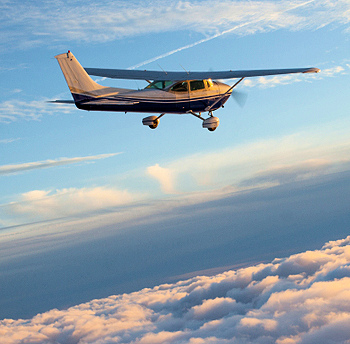Subscriber question:
"When should I start my descent? How fast should I descend? I know there are electronic tools that help with this planning, but is there a simple way to decide the best time to start down?" —Shawn P.
Wally:
 “Good descent planning takes some thought but it will pay off in efficiency and passenger comfort, so it’s clearly worth the effort. But how to do it safely, smoothly and efficiently; that is what we are trying to accomplish.
“Good descent planning takes some thought but it will pay off in efficiency and passenger comfort, so it’s clearly worth the effort. But how to do it safely, smoothly and efficiently; that is what we are trying to accomplish.
Let’s look at an easy example:
The air is smooth all the way down, we have no passengers with ear problems, and the 45 (degree) to the downwind is between us and the airport. In this case, we want to be at pattern altitude prior to entering the downwind leg. So simply subtract pattern altitude, let’s use 1000 MSL feet in this example, from your cruise altitude of 8500 MSL. This tells you that you need to descend 7500 feet. Now divide 7500 by 500 feet per minute and you will see that it will take approximately 15 minutes for the descent. If our ground speed is 120 knots, we will travel about 30 miles in 15 minutes. So, I would begin the descent about 32 miles away and attempt to maintain a 500 foot per minute rate of descent. This should get you to pattern altitude and stabilized prior to entering the downwind leg.
If you plan to fly over the airport either to enter the downwind leg on the other side of the airport or to simply inspect the airport, I use the same formula except I plan the descent to arrive over the airport at 2000 feet above airport elevation. So in the above example, I would begin that descent at 28 miles away.
If you have passengers with ear issues, you should plan on a more gradual descent. Whenever I have young children onboard I expect ear issues and plan accordingly. In that case, I plan on a 300 foot per minute descent. So, each one thousand feet will take a little more than 3 minutes.
Another issue is turbulence at the lower altitudes. Often on summer days, you can be cruising along at 8000 feet above those puffy clouds and in cool air. But from 5000 feet on down the air will be turbulent and temperatures will get hotter. These are the conditions that can make your passengers uncomfortable or even ill. So, I descend normally until I get to the top of the bumpy air and then level off. I stay there until I am quite close to the destination and then make a low power, slow speed descent at approximately 1000 feet per minute. Keeping the speed down reduces the severity of the turbulence, but you need to be watchful of passenger ear issues.
Naturally, winds will change as you descend and so will your ground speed, but it is easy to set a few benchmarks in the descent and then adjust as needed. For example in our first plan, I might decide that I should be descending through 4500 MSL as I pass 16 miles out. Now as I pass the 16-mile mark, I can adjust my descent if needed. I do this math while in cruise and write it down so I don’t have to work it out on the fly.
If I intend to make an instrument approach at the destination, I still use 500 feet per minute as my target and plan to be at the final approach crossing altitude 2 miles prior to that fix.”
How do you typically plan your long descents?
